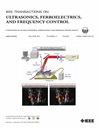Optically Validated Microvascular Phantom for Super-Resolution Ultrasound Imaging
IF 3
2区 工程技术
Q1 ACOUSTICS
IEEE transactions on ultrasonics, ferroelectrics, and frequency control
Pub Date : 2024-10-30
DOI:10.1109/TUFFC.2024.3484770
引用次数: 0
Abstract
Super-resolution ultrasound (SRUS) visualizes microvasculature beyond the ultrasound (US) diffraction limit (wavelength(用于超分辨率超声成像的光学验证微血管模型
超分辨超声(SRUS)通过定位和跟踪空间隔离的微泡造影剂,在超声衍射极限(波长(λ)/2)之外观察微血管。SRUS 模型通常由简单的管状结构组成,直径低于 100 μm 的通道不可用。此外,这些模型通常比较脆弱和不稳定,地面实况验证有限,其简单的结构也限制了对 SRUS 算法的评估。为了帮助 SRUS 的开发,需要具有已知生理相关微血管的坚固耐用的模型来进行可重复的 SRUS 测试。这项研究提出了一种制作耐用微血管模型的方法,这种模型可用于 SRUS 验证的光学测量。该方法使用嵌入聚二甲基硅氧烷的微血管负印模来制作微血管模型。具有不同微血管密度的分支微血管模型经过光学验证,血管直径小至 ~60 μm(λ/5.8;λ= ~350 μm)。进行了 SRUS 成像,并通过光学测量进行了验证。SRUS 平均误差为 15.61 μm(λ/22),标准偏差误差为 11.44 μm。当每个估计直径的局部微气泡数量超过 1000 个时,平均误差降至 7.93 μm(λ/44)。此外,制作一年后测量的声学和光学特性差异小于 10%,以及模型的机械韧性都证明了其长期耐用性。这项研究提出了一种制作耐用且经过光学验证的复杂微血管模型的方法,可用于量化 SRUS 性能并促进其进一步发展。
本文章由计算机程序翻译,如有差异,请以英文原文为准。
求助全文
约1分钟内获得全文
求助全文
来源期刊
CiteScore
7.70
自引率
16.70%
发文量
583
审稿时长
4.5 months
期刊介绍:
IEEE Transactions on Ultrasonics, Ferroelectrics and Frequency Control includes the theory, technology, materials, and applications relating to: (1) the generation, transmission, and detection of ultrasonic waves and related phenomena; (2) medical ultrasound, including hyperthermia, bioeffects, tissue characterization and imaging; (3) ferroelectric, piezoelectric, and piezomagnetic materials, including crystals, polycrystalline solids, films, polymers, and composites; (4) frequency control, timing and time distribution, including crystal oscillators and other means of classical frequency control, and atomic, molecular and laser frequency control standards. Areas of interest range from fundamental studies to the design and/or applications of devices and systems.

 求助内容:
求助内容: 应助结果提醒方式:
应助结果提醒方式:


